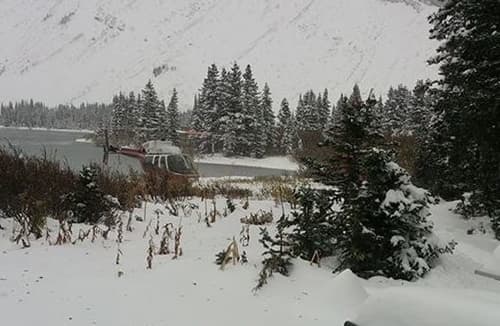 In late September, three experienced mountain hikers were on a two-night backpacking trip in Kananaskis Country, Alberta in the Canadian Rockies. On the second day of their trip, a heavy snowstorm hit and made it difficult to find the trail out. The trio was forced to retreat to the previous campground they had stayed at the night before. They had brought additional food and fuel and had ample shelter with two tents between the three of them. They were unsure of how long they would be stuck in the mountains and with dwindling cell phone reception, how they would call for help if needed.
In late September, three experienced mountain hikers were on a two-night backpacking trip in Kananaskis Country, Alberta in the Canadian Rockies. On the second day of their trip, a heavy snowstorm hit and made it difficult to find the trail out. The trio was forced to retreat to the previous campground they had stayed at the night before. They had brought additional food and fuel and had ample shelter with two tents between the three of them. They were unsure of how long they would be stuck in the mountains and with dwindling cell phone reception, how they would call for help if needed.Even though they were familiar with the backcountry location, the severe weather made it difficult to navigate. In the midst on the storm, they were able to follow tracks from other hikers but the heavy snowfall eventually covered the tracks up. Ian put fresh batteries in his Garmin GPS on Friday and only used the unit during the hiking portions of their trip. By Sunday afternoon, the cold weather and elevation had drained the batteries and they felt the best step to take was to retrace their steps back to Ribbon Lake and wait out the snowstorm.
On Sunday evening, the group hiked to the cliff site in search for the trail and the chains to descend down the mountain but was unable to locate them. One of Ian’s companions used to cellphone to take a photo and noticed he had a weak signal. Fortunately, they were able to call their spouses to let them know about the delayed arrival back home. The snow continued to fall throughout Sunday night and by Monday morning the campground was completely covered in knee deep snow. The alternate route was unfamiliar to the group and involved descending down a cliff using a series of 15-metre chains while wearing full backpacks. This was not a safe option, especially in the snowy weather.
To add to the danger, the group was in the heart of grizzly country! They heard from other campers that bears had been spotted nearby. Concerned about the bears, they spent a sleepless Sunday night huddled in their tents while the snow continued to fall. The sounds of animals nearby had their hands ready to grab the bear spray if needed.
At 4:30 am, Ian decided to activate the SOS on his SPOT device as the odds of the group hiking out seemed treacherous at best. Hours later, they decided to get up, start a fire, cook lunch, and pack up their gear before heading back to the area where they had poor cell service. They called Search and Rescue and learned that their SOS message was received, but due to the poor weather conditions, the SARs team could not deploy and a rescue may not be possible until Tuesday. Ian assured them that everyone was okay and that they had enough supplies to get them through another night if necessary.
Luckily, at around 2 pm, the weather cleared and about 45 minutes later, they heard a whirling sound of a helicopter approaching and they were able to signal the helicopter down to their exact location. Within five minutes of the rescue team’s arrival, they were in the air taking the most satisfying flight of their lives. They were dropped off a few kilometers from where their trip had begun and to their dismay, couldn’t find the car. It turned out that Ian’s daughter had moved the car to avoid it from getting snowed in. The Kananaskis Fire Chief picked the trio up and drove them back to Ian’s car.
Having SPOT certainly made a difference for Ian. Knowing he had the unit, he did not press the SOS until they felt like there were no other options but to call for rescue. Without it, they would have had to wait until either their families called in to say they were missing or until the weather was clear enough for them to attempt to hike out from the route they had originally taken in. “The cost of buying a SPOT, including the tracking costs and rescue insurance, is money well spent. Don’t gamble with your lives in the outdoors; by being prepared and carrying a SPOT with you, the odds of surviving a harrowing or unexpected experience are greatly increased. Consider it LIFE insurance!” said Ian Scott.